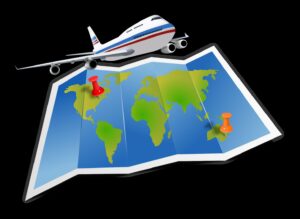9 Countries With Digital Nomad Visas If Your Company Allows WFA & How To Apply For Them
18 min readCountries with digital nomad visas
We’re all for WFH – there’s no need to make small talk with colleagues you don’t really like, you get the peace and quiet needed to chiong your business report, and if you need to take a quick snooze to recharge, your bed is just there and there’s no one around to judge you for it. Now imagine doing all that while you’re on a work-holiday. You get those perks plus the added benefit of exploring another city or country that isn’t your own. That’s the beauty of a digital nomad visa; here’s how you get one:
Table of Contents
What is a digital nomad visa?
Think of it as a permit that allows you to extend your stay in a foreign country without having to quit your job back in your home country. It mostly serves digital nomads who have the luxury and flexibility of being able to do their jobs as long as they have an internet connection and a laptop.
It’s important to note that those holding on to remote working visas aren’t allowed to conduct revenue-generating businesses in the host country they’re staying in. This means you aren’t allowed to operate factories and companies or hire locals to help out with your business. You can, however, conduct business meetings in person whenever needed.
The visa usually exempts holders from having to file income tax twice – once in their home country and another in the host country. For the most part, Singapore has double tax agreements with a number of countries, including all on this list, except for Iceland and Dubai. You can check the full list of double tax agreements on IRAS.
| Country | Best for | Visa-free stay for Singapore citizens | Digital nomad visa stay | Name of visa | Minimum salary needed |
| Thailand | Beaches & city life | 30 days | 1 year | Non-Immigrant Visa B | Not specified |
| Indonesia | Digital nomad hub & kid-friendly activities | 30 days | 1 year | 1-Year E33G Visa | US$60,000/year (~S$81,068.70) |
| Malaysia | Affordable cities | 30 days | 3-12 months (renewable) | DE Rantau Digital Nomad Pass | US$24,000/year (~S$32,411.40) |
| South Korea | Connectivity & convenience | 90 days | 1-2 years | F-1-D Workation Visa | S$7,600/monthly |
| Taiwan | Safe & friendly locals | 30 days | 6 months – 3 years | 6-Month Taiwan Tourist Visa/Gold Card | Tourist Visa: None Gold Card: Dependent on individual |
| Iceland | Long summer days | 90 days | 3-6 months | Long-Term Visa For Remote Workers | ISK1,000,000/month (~S$9,827) |
| Spain | Lower cost of living in Europe | 90 days | 1 year | Digital Nomad Visa | S$3,324.62/month |
| Dubai | Fast internet & tax benefits | 30 days | 1 year | Virtual Work Residence Permit | US$3,500/month (~S$4,728.57) |
| Japan | Culture & diverse activities | 90 days | 6 months | Digital Nomad Visa | ¥10 million/year (~S$85,820) |
What to prepare before working remotely overseas
Paperwork – Visas, HR policies & paychecks
You already know you’ll need to get your paperwork in order, such as the right visas for yourself and any accompanying family members if any. Your passport should also be valid for however long you plan to stay, so you don’t run the risk of becoming an illegal immigrant. Singapore requires citizens to have at least a 6-month validity on their passport in order to return home, BTW.
Of course, you should check in with your employers before scooting off for an extended Work From Away (WFA) situation. If there’s no set HR policy for WFA matters, take a lead from our colleague who did a whole presentation for his HODs to allow him to do remote work in Canada. He took into consideration the different time zones and how he could still maintain efficiency even though he would be across the world from the rest of the team.
You might also want to check in with your HR and finance teams on how you’d be receiving your pay and if you still get CPF. FYI, employers are not obligated to contribute to your CPF account if you’re posted overseas.
If you’re only going to be gone temporarily, it’s a good idea to check what local ATMs there are in your host country where you can withdraw money from your Singapore bank account. Otherwise, if you plan on staying for much longer, you might want to set up a bank account in the host country that your employer can wire funds to.
Most countries require proof of residency and an accompanying visa before you’re allowed to open a bank account as a foreigner. Local bank accounts at least open up services meant just for locals, like using PayNow in Singapore.
Accommodation
For accommodations, serviced apartments and even Airbnb are great for short-term stays since these come already fully furnished. Most of these places even offer housekeeping services so that’s one less thing to worry about as you use your time off to explore the country. If serviced apartments aren’t available, write in to hotels to see if they have discounted rates for longer stays.
Insurance
Even if you never end up claiming anything, insurance is always good to have on hand for just-in-case moments. While you might be insured already in Singapore, it’s wise to check if your policies cover accidents overseas.
1. Thailand

Night market in Thailand.
All of us know someone who makes an annual pilgrimage to Thailand to conquer Bangkok night markets, laze around at Phuket beach clubs, and dance the night away at a Full Moon party. Maybe that person is you and you’re looking for a way to make that next flight out a one-way one. Good news, you can apply for a Thailand digital nomad visa.
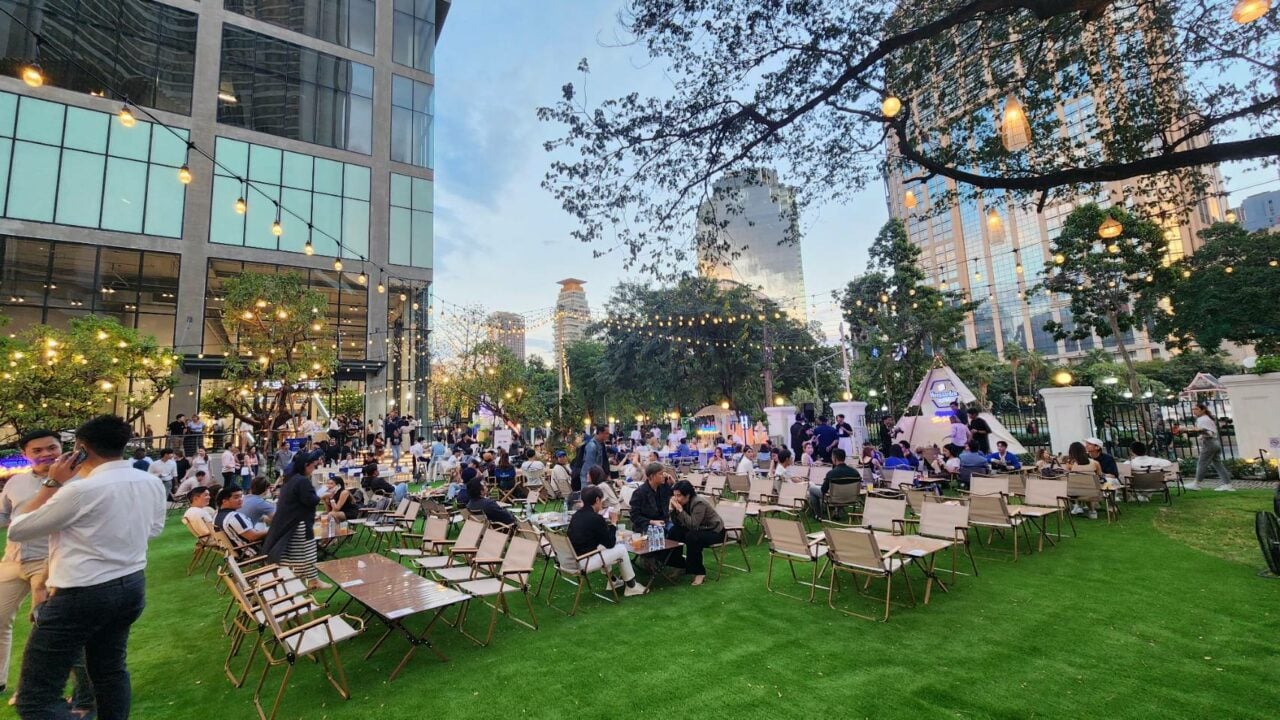
The new EmSphere also has an outdoor area for you to hang out with your friends.
Image credit: Daily News
The visa only lasts a year, but that’s at least 50 weekends you can spend crossing off every activity on this list of things to do in Bangkok. Repeat visitors who’ve already done everything can always check out new things to do in Bangkok like the recently-opened EmSphere mall that has more than 1,000 retail stores under one roof.

Cafes in Chiang Mai are a great mix of nature, good food, and IG-worthy photo ops.
But the beauty of Thailand is that you don’t have to relegate yourself to the city for a WFA experience. Take to the beaches on Thailand’s many islands if you want your colleagues to be jealous of your real tropical Zoom background. Or if the simpler life in the country calls you, there’s always the paddy fields in Chiang Mai to explore.
How to apply for Thailand digital nomad visa:
Singaporeans are allowed to stay in Thailand without a visa for a maximum of 30 days. After which, you can apply for the Non-Immigrant Visa B that extends your stay from 90 days to 1 year.
You’ll have to apply for an online visa application first then make an appointment with the Royal Thai Embassy to register for your visa. The whole process takes at least 3 weeks but it’s recommended that you start applying at least 1 month before your intended arrival date to gather all the necessary documents, such as an original letter from your employer, and a certified business profile from ACRA.
Find out more about the Thailand Non-Immigrant Visa B.
2. Indonesia
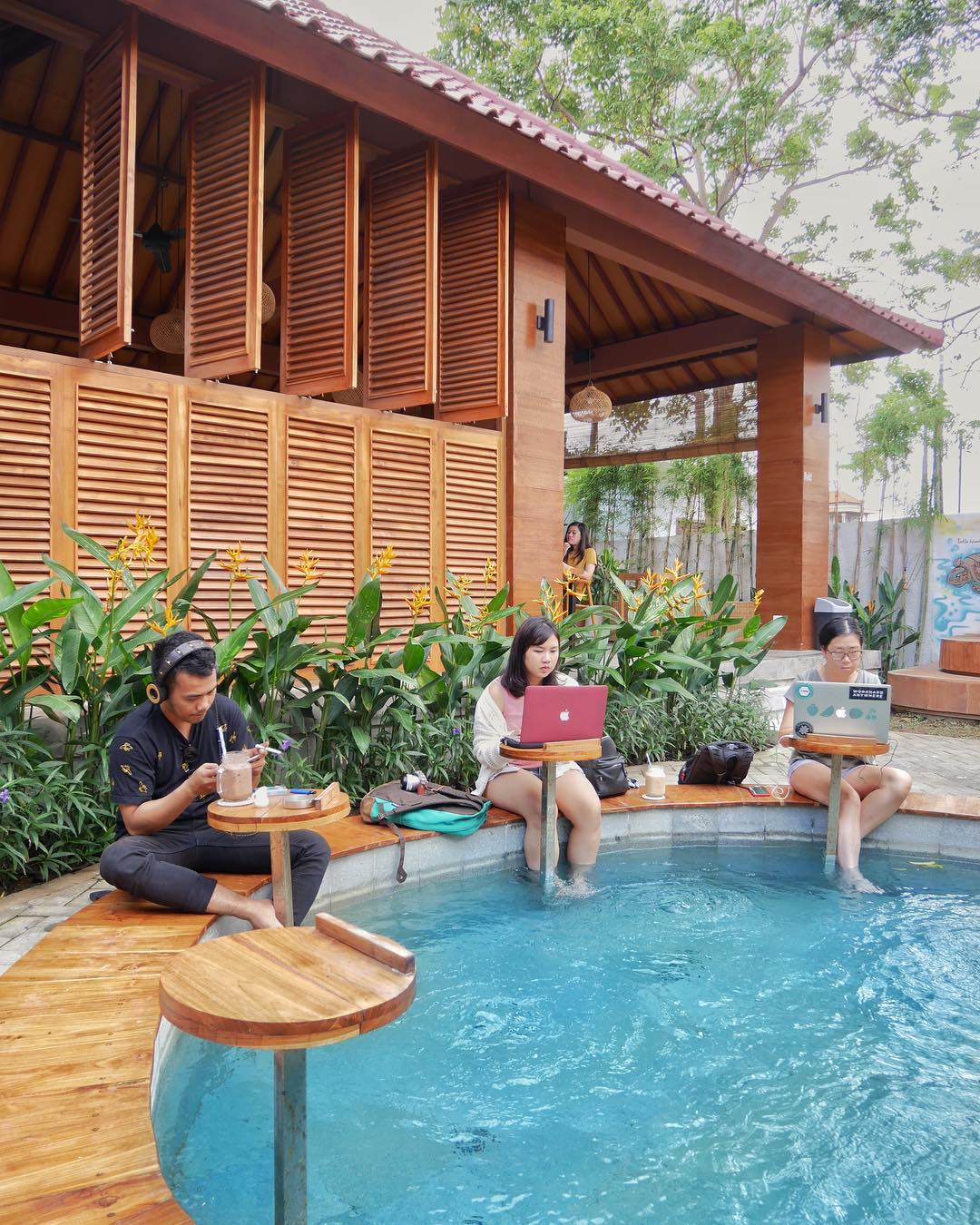
Only in Bali would you have co-working spaces with a pool.
Image credit: @biliqbali via Instagram
LBR, if Indonesia is on your radar for WFA, it’s probably Bali you want to head to. After all, it’s digital nomad central. You’ll find Bali co-working spaces in just about any neighbourhood, many of which even have networking events for you to find your next client or business partner.

Tegalalang Rice Terrace in Ubud.
Outside of work, this list of things to do in Bali will keep you busy. And no, it doesn’t just include beach clubs and nightclubs to chillax at. Bali’s appeal is definitely its nature – think rocky cliffs overlooking crystal blue water, waterfalls with pools you can wade in, and hiking trails that lead you to terraced rice paddy fields.

Waterbom Bali.
While Bali attracts hordes of millennials and up for remote work, the island has become increasingly popular with families with children for their kid-friendly attractions. There are thrilling water slides at Waterbom Bali, indoor go-karting at Trans Studio Mall Bali, and wild animals to feed at Bali Safari & Marine Park to ensure the little ones are never bored.
How to apply for Indonesia digital nomad visa:
With a Singaporean passport, you can stay for 30 days visa-free. In fact, our passport is also eligible for the Bali airport autogates, which allow you to breeze through immigration without having to join the long queues.
But, if you want to stay longer, there’s a 60-Day Visa On Arrival that you can apply for on the Indonesian immigration website or the VOA counter after touching down for IDR500,000 (~S$42.39).
To stay for up to 12 months, apply for the 1-Year E33G Visa, which requires a completed visa application form and an appointment at the Indonesian Embassy in Singapore. You’ll need to prove you earn an annual income of at least US$60,000 (~S$81,068.70) and have at least US$2,000 (~S$2,696.62) in your bank account.
If approved, you’ll be provided with an electronic visa and identification card. The card must be carried on your person at all times while you’re in Indonesia.
Find out more about the 60-Day Visa on Arrival and 1-Year E33G Visa.
3. Malaysia
With the constant jams along the causeway on weekends and every public holiday, it’s safe to say that we Singaporeans love Malaysia. But it’s not just for the quick jaunts to JB to visit shopping malls like Toppen Shopping Centre or Sunway Big Box Johor for cheap buys.

You don’t need to work in a co-working space, not when the local cinema at GSC LaLaport BBCC has lounges like this.
Digital nomads are also flocking to KL, as it’s a global business hub with many MNCs headquartered in Malaysia’s capital city. If your company has a Malaysian office, you could technically still clock WFO hours if that’s a requirement, while still enjoying perks like a lower cost of living as compared to Singapore.
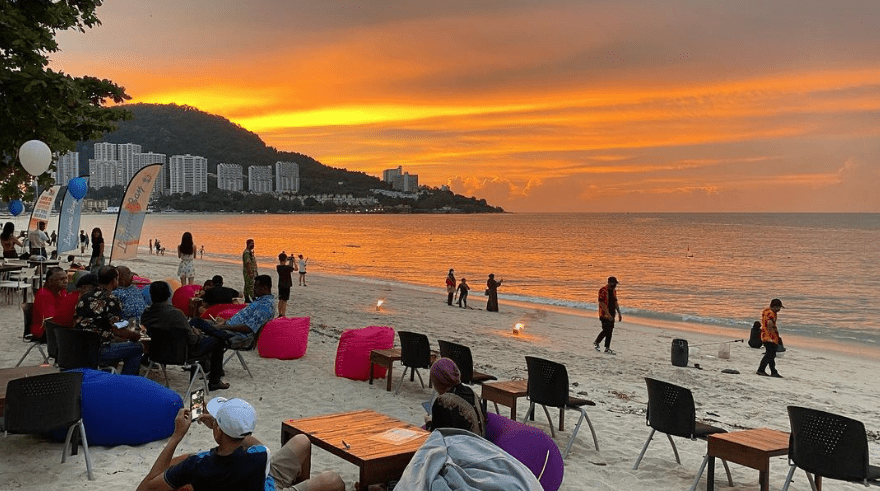
Laguna Bay Penang where you can check emails while you’re having a beer by the beach.
Image credit: @jmcc68 via Instagram
But you don’t have to go all the way to KL for the digital nomad experience. Consider Penang, which is known for its cafe culture and co-working spaces in the city centre of George Town. If you want a change in scenery, the beach is just a half-hour drive away.
Of course, if you don’t want to be too far from home, JB is also gaining popularity among Singaporean digital nomads since it’s just across the causeway. Our guide to living in JB as a Singaporean has the details on how to extend your stay as a permanent resident of JB.
How to apply for Malaysia digital nomad visa:
You don’t need a visa if you’re planning to shuttle back and forth between Malaysia and Singapore. You’re allowed to stay for a maximum of 30 days per run if you want. But if you intend to stay longer, then sign up for the DE Rantau Digital Nomad Pass.
The pass is valid for 3-12 months and is renewable for another 12 months for a total of 24 months. You’ll even be able to bring in dependents or a spouse on this visa. Applications are open to all nationalities and can be done completely online.
Requirements include making more than US$24,000/year (~S$32,411.40), which you’ll have to show proof of through payslips or bank statements, if you’re a freelancer. The application takes anywhere between 6-8 weeks, so you’ll want to plan well in advance before moving to Malaysia. You’ll also have to pick up your pass sticker at the High Commission of Malaysia in Singapore before entering the country as a digital nomad.
Find out more about the DE Rantau Digital Nomad Pass.
4. South Korea
Here’s one reason you can use to convince your boss that you should be allowed to WFA in South Korea: this country is one of the most well-connected in the world. It’s harder to find someone without mobile data than it is to find free WiFi. Now there’s no excuse to delay sending in your reports just because the internet at home has gone out.
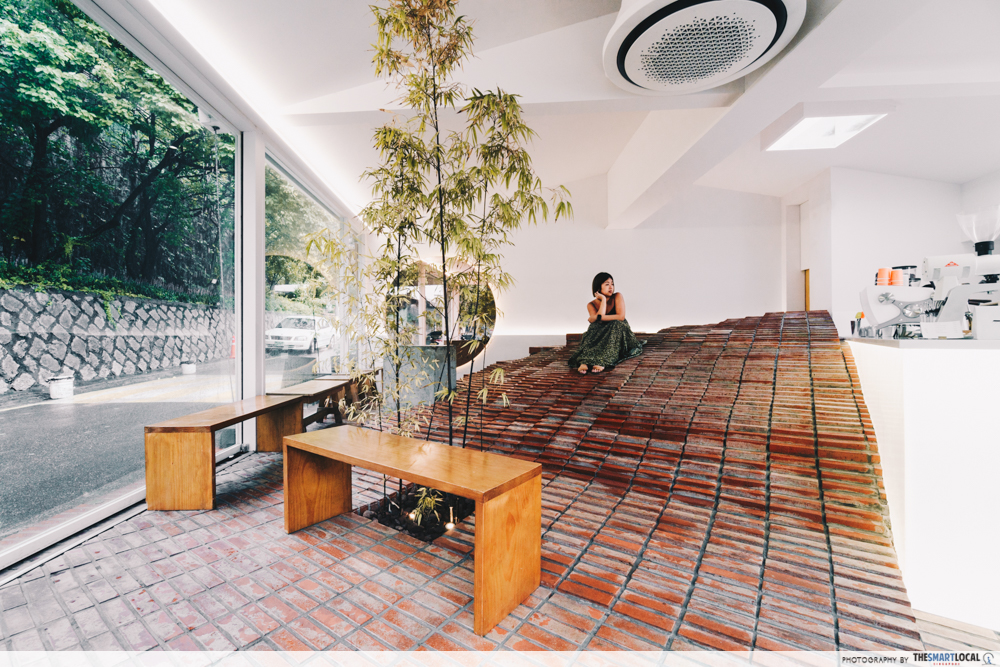
Possibly not the best place for your posture, but still an IG-worthy cafe to get work done in.
But it’s not just the connectivity that has drawn hordes of digital nomads to South Korea. Major cities like Seoul and Busan have countless themed cafes to work in, if co-working spaces aren’t your thing. Best of all, lots of these cafes provide free WiFi, as long as you purchase a drink or food item.

You might know Jeju as a beach paradise, but the island also has lesser-known forest trails to visit.
Image credit: @sanyang_keunkot via Instagram
When you’re off duty, South Korea has no shortage of activities to keep you occupied. For one, you don’t have to limit yourself to just the city you’ve based yourself in. South Korea is well-connected enough that even flying to Jeju takes just about an hour.
And while you may know this place for its shopping, that doesn’t mean you have to splurge to enjoy yourself here. Hostels in Seoul hover around the S$55/night range and there are budget things to do in Seoul coming in at less than S$10 per activity.
How to apply for South Korea digital nomad visa:
A plus point for picking South Korea as your base for your digital nomad lifestyle is that Singapore citizens can stay 90 days visa-free here. But if you want to extend your stay to 1-2 years, then you’ll need to apply for the F-1-D Workation Visa.
Application for the F-1-D Workation Visa is fairly straightforward but involves preparing a long list of documents, including bank statements to show a monthly income of S$7,600, proof of medical insurance of at least S$150,000, and even a certificate of clearance from the Singapore Police Force.
It’s easiest to engage with an approved South Korea Visa Agent in Singapore, who can help to prep everything for you.
There’s no paper visa issued, but you can download a copy via the Korea Visa Portal if needed. You’ll also need to apply for a Registration Card at an immigration office when you arrive in South Korea. The card needs to be returned when you leave South Korea.
Find out more about the F-1-D Workation Visa.
5. Taiwan
When it comes to choosing a place in Asia to be a digital nomad, Taiwan ranks high on the list for a multitude of reasons. It’s safe, has an affordable cost of living, and has an extensive public transport system, so it’s easy to get around. While Mandarin Chinese is the official language, many Taiwanese, especially younger ones, can speak English well.

Get work done at Taipei 101’s Starbucks for gorgeous views of the city.
Taiwan also offers great co-working culture, not just in the capital of Taipei. Just about any major city like Taichung, Kaohsiung, and Hsinchu has a multitude of co-working spaces to choose from.

The Dadaocheng Wharf Container Market sells fusion street food all day long.
Image credit: Let’s Play TW
When it comes to after-work activities, Taiwan is known for its nightlife. Obviously, we’d have to mention the many night markets peppered around the country that serve street food. Many of them, like Shilin Night Market, sell beer to pair with their food, so it’s commonplace for younger Taiwanese to pre-game here before heading to a club. Then it’s party time till as late as 4am in most clubs around Taipei.
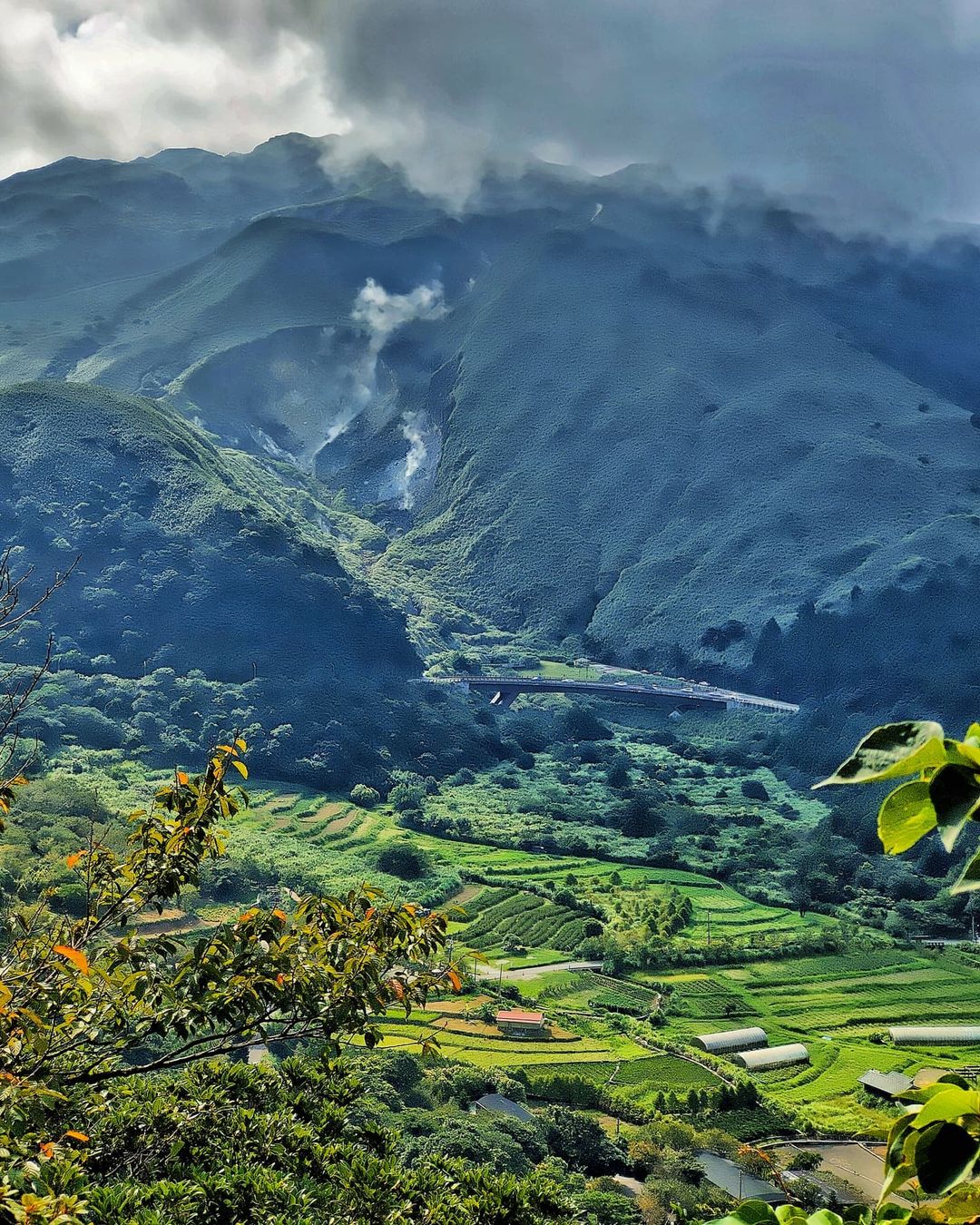
Qixing Mountain in Yangmingshan National Park.
Image credit: @alexturner.photo via Instagram
If you’d rather pitch a tent than raise the roof, Taiwan also has lots of nature to explore, like Yangmingshan National Park, the hot springs of Beitou, and paddy fields of Yilan. All of which can be accessed via public transport or through a tour group.
How to apply for Taiwan digital nomad visa:
You’re allowed to stay in Taiwan for 30 days without a visa on a Singapore passport. If you want to stay up to 6 months, consider the 6-Month Taiwan Tourist Visa. Complete the Visa General Application Form first, then apply in person at the Taipei Representative Office in Singapore with documents such as bank statements, itineraries, and tour packages for Taiwan.
Find out more about the 6-Month Taiwan Tourist Visa.
There’s also the Taiwan Employment Gold Card that’s valid for 1-3 years’ stay in Taiwan. This one is harder to obtain, as qualifications are strict and limited to experts in their fields. This includes national athletes, lawyers, architects, and STEM professionals. You can use the Taiwan Employment Gold Card Qualification Quick Check to see if you qualify.
From there, it’s just a matter of applying for the right visa under the Taiwan Employment Gold Card. Once permitted, a cardholder has the right to obtain employment in Taiwan, stay in Taiwan for more than 180 days at a time, and is allowed multiple entries and exits into Taiwan.
Find out more about the Taiwan Employment Gold Card.
6. Iceland
When people think of remote working destinations, you’d probably list places like Bangkok and Bali way before you’d even consider Iceland. But this Nordic island is welcoming of digital nomads, giving Singapore passport holders 3 months visa-free.

Lake Thingvallavatn, the largest lake in Iceland.
Digital nomads in Iceland recommend coming in the summer to experience a phenomenon called “midnight sun”, where you get up to 22 hours of daylight in a day. That means attractions are open that much longer – way past working hours of 9-6.
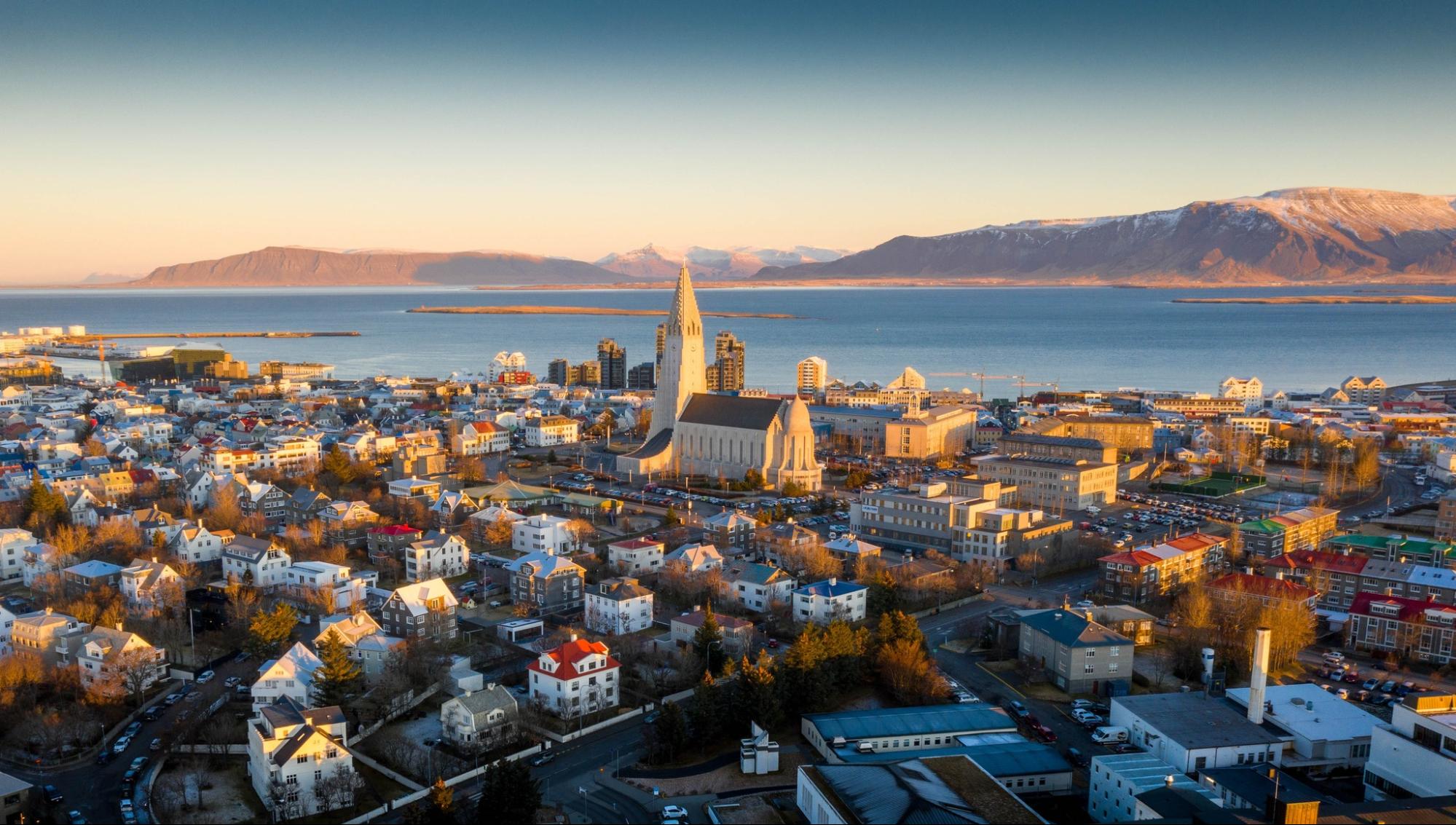
Reykjavik City.
Image credit: @marinatraveliceland via Instagram
The only catch is that Iceland can be quite an expensive city to live in, and getting around can be a bit of a hassle without a car. Main cities like Reykjavik and Kópavogur are walkable, but if you want to explore the glaciers and beaches, renting a car is a must unless you book a tour.
How to apply for Iceland digital nomad visa:
It’s visa-free for up to 90 days in any 180-day period for Singaporeans. After which, you can apply for a Long-Term Visa For Remote Workers, that allows digital nomads to stay in Iceland for 90-180 days.
Application is relatively simple but can’t be done online. You’ll need to make a bank transfer of ISK12,000 (~S$120) to the Directorate of Immigration first before mailing in your application. This includes receipt of payment, confirmation of employment by your employer, and payslips stating a monthly income of ISK1,000,000/month (~S$9,827).
You’ll receive notice from the Directorate if your application has been approved. Contact the Directorate of Immigration after you arrive in Iceland and they’ll then issue you your visa. The date of validity starts from the day you receive your visa.
Find out more about the Iceland Long-Term Visa For Remote Workers.
7. Spain
On our side of the world, it’s Southeast Asian countries like Thailand, Indonesia, and Malaysia that digital nomads prefer for their affordable cost of living. In Europe, the hub of choice for digital nomads is Spain.

Royal Square in Catalonia.
Spain offers many advantages, such as a lower cost of living compared to other European countries like Denmark, France, and Italy. Their Digital Nomad Visa is also flexible and allows self-employed remote workers to also work for Spanish companies, provided it doesn’t consist of more than 20% of their total work hours.

Want the beach? Calella de Palafrugell is just 1.5 hours from Barcelona.
Plus, it has the advantage of being part of the European Union and Schengen Agreement. If you have a remote work visa that allows multiple exits and entries into the country, you’re pretty much free to explore 30 other countries, including Portugal, Germany, Croatia, and Finland for up to 90 days at a time.
And yes, siestas are a thing, even for office workers in Spain. It might not bode well for remote workers who need to adhere to a strict schedule to keep operations going in their original country of employment. But for those who have more flexibility in their workday, the 2-3 hours means getting to enjoy lunch, a stretch, and some rest before heading straight back into work.
How to apply for Spain digital nomad visa:
Singapore passport holders get 90 days visa-free already for tourism or business reasons. But you can opt to stay longer with their Digital Nomad Visa. You’ll first have to apply for a Foreigner Identity Number, known in Spain as an NIE. This can be done after you’ve arrived in Spain or at the Embassy of Spain in Singapore.
Once that’s approved, apply for the Digital Nomad Visa online. You’ll need to show proof that you’re earning 200% of the national minimum wage, which is currently €1,134/month (~S$1,662.31). So you must make a minimum of S$3,324.62/month to qualify. Visa applicants must also show proof that they’re degree holders with at least 3 years of work experience.
Find out more about the Spain Digital Nomad Visa.
8. Dubai

Dubai looks like this.
While South Korea is one of the most well-connected countries, it is Dubai that boasts one of the fastest internet speeds in the world. So, if your work entails lots of video conferencing calls, and sending and receiving large documents, consider adding Dubai to your digital nomad world tour.

But also this.
It’s not just fast internet speeds that digital nomads enjoy in Dubai. For many, the draw here is its central location between Europe and Asia, especially if your work involves lots of travelling between the 2 continents.

The artsy district of Al Serkal Avenue has cosy cafe spaces, if desks aren’t your vibe.
Another perk of being a digital nomad in Dubai is the cheaper entry point in being one. Most countries ask for remote workers to show a monthly income of about US$10,000/month, but in Dubai, you only need to show you earn at least US$3,500/month (~S$4,728.57), which is closer to the median salary of S$5,197/month in Singapore.
Then there’s the appeal of not having to pay any additional taxes while you’re here. Dubai doesn’t have a double tax agreement with Singapore, but they don’t charge their citizens income tax at all. Just file your income tax in Singapore and you’ll be good to go.
How to apply for Dubai digital nomad visa:
You get a free 30-Day Visa On Arrival once you land in Dubai. For longer stays of up to 1 year, you can apply for a Virtual Work Residence Permit that’s valid for 1 year. You can apply for it online and you just need to show proof of a monthly income of US$3,500/month (~S$4,728.57) and pay US$611 (~S$825.81) in processing and application fees.
If the consulate doesn’t require further information from you, your application can be approved in as quickly as 48 hours. The visa allows you multiple entries and exits from Dubai, but you cannot be away from Dubai for more than 6 months, or your visa will be revoked.
Find out more about the Virtual Work Residence Permit.
9. Japan

Japan – home of futuristic exhibitions like this one at teamLab Planets Tokyo Toyosu.
A digital nomad visa to Japan has been a long time coming for those of us who can’t get enough of onsen spas, ryokans with views of Mount Fuji, and countless theme parks like Super Nintendo World at Universal Studios Japan and Ghibli Park. Good news, the visa recently launched on 31st March 2024 and is open to Singapore citizens.

Image credit: @ak1c_ha_n0 via Instagram
With it, you’ll be allowed to extend a visa-free stay of 90 days to up to 6 months. It’s enough time to explore at least half of the seasons available in Japan. Our pick – winter and spring, so you can experience snow and maybe pick up skiing and snowboarding at a ski resort in Japan. Spring is a must, if you want to catch the elusive cherry blossom season.
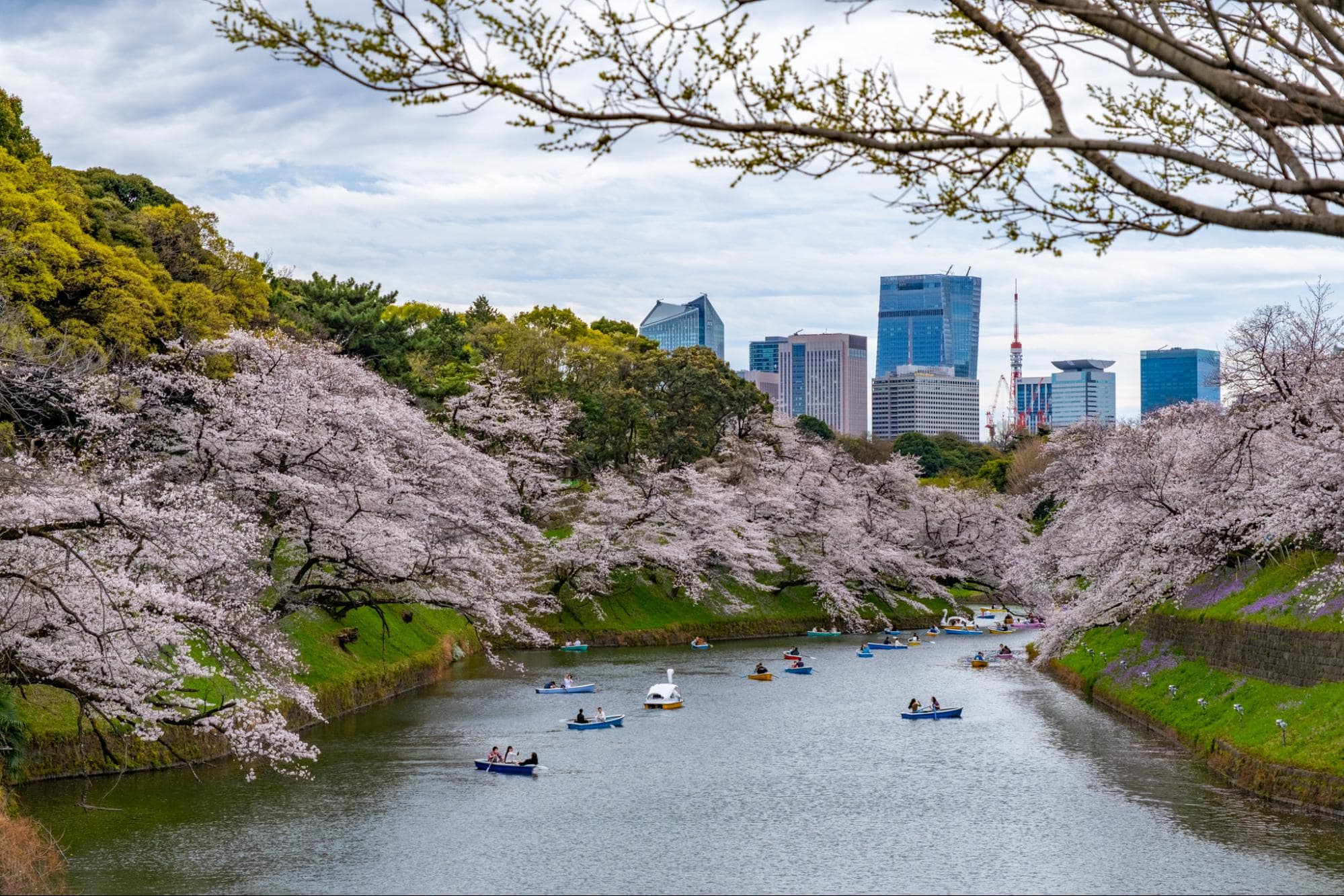
Image credit: Andrea Conway via Facebook
When it comes to doing work, you’ve got your choice of options not limited to just co-working spaces. Digital nomads have cited off-peak karaoke booths, multi-storey sentos (public baths), and net cafes or manga cafes as conducive places to do work.
How to apply for Japan digital nomad visa:
You must apply for a Certificate of Eligibility (COE) that would qualify you for a digital nomad visa. The COE will check for requirements such as letters from your company approving your WFA in Japan and income statements showing an annual income of ¥10 million (~S$85,820).
Only after you’ve been given your COE can you apply for the Japan Digital Nomad Visa that’s valid for 6 months. Fill in the Digital Nomad Visa application form, then make an appointment with the Embassy of Japan to submit all your relevant documents. The embassy will let you know if you’ve been approved for a visa after 5 working days.
Find out more about the Japan Digital Nomad Visa.
How to apply for a remote working visa overseas
If your company allows you to WFA, then lucky you. Take advantage of it by working overseas for a change in scenery. In most cases, you don’t even need a digital nomad visa, if you’re only planning to be in the country for a couple of weeks.
But if you do want to stay for much longer, then bookmark this list. All that’s left after is to pack your bags, grab your laptop, and book your flight tickets out of here.
More things to do with your Singapore passport:
